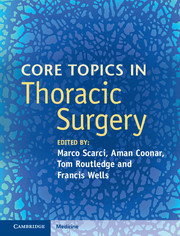Book contents
- Frontmatter
- Contents
- List of contributors
- Section I Diagnostic work-up of the thoracic surgery patient
- 1 Lung function assessment
- 2 Endobronchial and endoscopic ultrasound for mediastinal staging
- 3 Staging of lung cancer: mediastinoscopy and VATS
- 4 Access to the chest cavity: safeguards and pitfalls
- Section II Upper airway
- Section III Benign conditions of the lung
- Section IV Malignant conditions of the lung
- Section V Diseases of the pleura
- Section VI Diseases of the chest wall and diaphragm
- Section VII Disorders of the esophagus
- Section VIII Other topics
- Index
- References
4 - Access to the chest cavity: safeguards and pitfalls
from Section I - Diagnostic work-up of the thoracic surgery patient
Published online by Cambridge University Press: 05 September 2016
- Frontmatter
- Contents
- List of contributors
- Section I Diagnostic work-up of the thoracic surgery patient
- 1 Lung function assessment
- 2 Endobronchial and endoscopic ultrasound for mediastinal staging
- 3 Staging of lung cancer: mediastinoscopy and VATS
- 4 Access to the chest cavity: safeguards and pitfalls
- Section II Upper airway
- Section III Benign conditions of the lung
- Section IV Malignant conditions of the lung
- Section V Diseases of the pleura
- Section VI Diseases of the chest wall and diaphragm
- Section VII Disorders of the esophagus
- Section VIII Other topics
- Index
- References
Summary
Introduction
The choice of incision is vital for procedures in the thoracic cavity. The main principle should always be adequate exposure in order to perform a safe and effective procedure without compromise. However, the trauma of entering the chest cavity is particularly severe with impact on pain, muscle performance and respiratory function. As with surgical access in any region of the body, surgeons have always tried to minimize the impact of this trauma in the thoracic wall. As a result, we have at our disposal a myriad of incisions to choose from when facing thoracic procedures, with their own indications and pitfalls. As a general rule, in order to decide our approach, we have to take into account the indication for surgery, the anatomical location of the pathology, the likelihood of encountering difficulties (such as previous surgeries or locally invasive tumours), the pre-operative assessment of the patient, the predicted extent of side effects and also the patient's views in term of cosmesis and recovery.
Common to all techniques are the basic principles: correct positioning of the patient on the operating table, anatomical landmarks to place the incision, correct tissue handling and haemostasis and gradual spread of ribs/sternum to minimize trauma. For the purpose of this chapter, we will divide the incisions into three main groups: open approaches in lateral decubitus position (muscle and non-muscle sparing), open approaches in supine position (sternotomy, anterior thoracotomy, clamshell and their variations) and minimally invasive approaches (VATS and hybrid). We will describe the techniques with points regarding their main indications and their potential pitfalls.
Techniques
Open approaches in lateral decubitus
The majority of the chest wall approaches for thoracic surgery procedures are still performed in the lateral decubitus position. It is crucial that multiple pressure points are padded, with the dependent leg flexed with a pillow between the legs. Ideally, both arms should be flexed ‘in the prayer position’, although this can vary depending on the surgeon's preference. It is important to widen the intercostal spaces to be entered by hyperextending the chest cavity with a roll positioned under the dependent chest at the level of the tip of the scapula or by ‘breaking’ the operating table mechanism.
- Type
- Chapter
- Information
- Core Topics in Thoracic Surgery , pp. 25 - 38Publisher: Cambridge University PressPrint publication year: 2016



